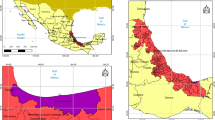Abstract
An overall dynamic model for a high-rise building hot water heating (HWH) system was developed. This dynamic model was employed to analyze the characteristics of a HWH system and to simulate a pressure-temperature control (PTC) strategy. The dynamic responses of the water mass flow rate, pressure, temperature, and motor speed were studied. The simulation results show that the pressure control strategy is able to reduce the pressure fluctuations in the system and as well as interact positively with the thermal system in maintaining zone air temperatures at the chosen set points. The results also show that the use of pressure control strategy resulted in lower water mass flow rates in the system compared to the design mass flow rate.

















Similar content being viewed by others
Abbreviations
- A :
-
Area (m2)
- A d :
-
Perimeter of pipe section (m)
- B :
-
Fraction factor (kg·m2/s)
- c :
-
Specific heat (J/kg·°C)
- C :
-
Thermal capacity (J/°C)
- C f :
-
Friction coefficient
- dx :
-
Length along the pipe (m)
- D :
-
Diameter (m)
- e:
-
East
- e:
-
Error
- F :
-
Friction force (Pa)
- H :
-
Pump head (Pa)
- HV :
-
Heat value (J/kg)
- I :
-
Current (Amps)
- k p :
-
Proportional gain
- k i :
-
Integral gain
- L :
-
Length of heater or pipe (m)
- \( \overset{\cdot }{m} \) :
-
Mass flow rate (kg/s)
- m :
-
Mass per unit length (kg/m)
- M :
-
Matrix
- N :
-
Speed (rpm)
- n:
-
North
- P :
-
Pressure of water (Pa)
- q :
-
Rate of heat transfer per unit area (W/m2)
- Q :
-
Rate of heat transfer (W)
- R:
-
Ratio
- s:
-
South
- t :
-
Time (s)
- T :
-
Temperature (°C)
- u :
-
Control variable
- U :
-
Enclosure heat loss rate (W/m °C)
- V :
-
Velocity (m/s)
- w:
-
West
- ρ :
-
Density (kg/m3)
- ξ :
-
Friction coefficient
- η :
-
Efficiency
- λ :
-
Thermal conductivity (W/m °C)
- b:
-
Boiler
- d:
-
Design condition
- e:
-
East
- f:
-
Fuel
- fit:
-
Fittings
- i:
-
Internal or branch
- in:
-
Input
- int:
-
Internal heat sources
- j:
-
Direction of zone
- k:
-
Number of outside wall
- l:
-
Hour
- max:
-
Maximum
- n (superscript):
-
Factor
- n (subscript):
-
North
- o:
-
Outside
- out:
-
Output
- pre:
-
Previous
- r:
-
Return
- rm:
-
Room
- s:
-
Supply water or south
- sf:
-
Surface
- sp:
-
Set point
- tot:
-
Total
- v:
-
Control valve
- w:
-
Water or west
- z:
-
Zone
References
Boysen H. & Thorsen J. E. (2003). How to avoid pressure oscillations in district heating systems, Technical paper, published in Euroheat & Power, English Edition II.
Datwyler T.T. (2012). Hydraulic modeling : pipe network analysis, Maters thesis, department of Civil and Environmental Engineering, Utah State University, Logan, Utah, 2012.
Hassig C. (1999). Adaptive fuzzy temperature control for hydronic heating systems, Proceedings of the International Conference on Control Applications, (1): pp582-588
Lianzhong, L., & Zaheeruddin, M. (2007). Hybrid fuzzy logic control strategies for hot water district heating systems. Building Services Engineering Research and Technology, 28(1), 35–53.
Lianzhong, L., & Zaheeruddin, M. (2008). Dynamic modeling and fuzzy augmented PI control of a high-rise building hot water heating system, energy for sustainable development. The Journal of the International Energy Initiative, XII(2), 49–55.
Lucian, S., Rodica, F., Liviu, H. (2007). Hydraulic Stability in District Heating Pipe Systems, 2nd IAHR International Meeting of the Workgroup on Cavitation and Dynamic Problems in Hydraulic Machinery and Systems, Romania.
McQuiston, F.C. & Parker, J.D. (2005). Heating, Ventilating, and Air Conditioning Analysis and Design, 6th Editio. Wiley.
Metzger, M. (1993). Modeling and simulation of transient states in the heat distribution network. Systems, Man and Cybernetics, Systems Engineering in the Service of Humansapos, International Conference, 5, 136–141.
Olsson, M. (2010). Design principles for hydronic heating systems : constant and variable flow control systems, Thesis in the department of energy and environment. Göteborg: Chalmers University of technology.
Thoma, J. U., & Richter, D. B. (1987). Simulation of fluid pipes in hydrostatic circuits using modal and segmental methods. Transactions of the Society for Comparative Simulation, 3(4), 337–349.
Vladimir, D. S., Sanja, P., Blazenka, M., Branislav, Z., & Srdjan, N. (2007). Efficient numerical method for district heating system hydraulics. Energy Conversion and Management, 48(5), 1536–1543.
Walski, T.M. (1984). Analysis of water distribution systems, 1984 :Van Nostrand Reinhold Company
Xuzhong, Q., Yi, J., & YingXing, Z. (2001). Optimization of Hydraulic conditions in district heating networks. ASHRAE Transactions, 107(1), 270–274.
Zheng G.R. (1997). Dynamic Modeling and Global Optimal Operation of Multizone Variable Air Volume HVAC System, PhD Thesis, Concordia University, Canada.
Acknowledgments
Research grant for this project from the Natural Sciences and Engineering Research Council (NSERC) of Canada is gratefully acknowledged.
Author information
Authors and Affiliations
Corresponding author
Rights and permissions
About this article
Cite this article
Li, L., Zaheeruddin, M. Pressure and temperature control analysis of a high-rise building hot water heating system: a simulation study. Energy Efficiency 8, 773–789 (2015). https://doi.org/10.1007/s12053-014-9321-3
Received:
Accepted:
Published:
Issue Date:
DOI: https://doi.org/10.1007/s12053-014-9321-3




